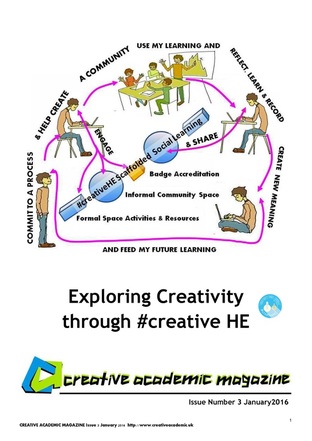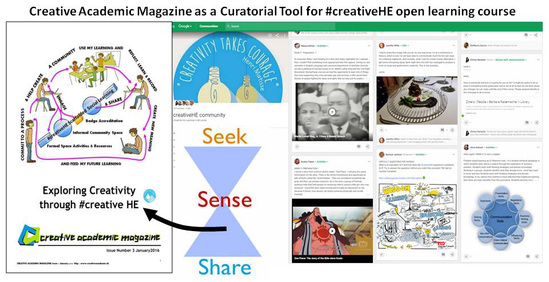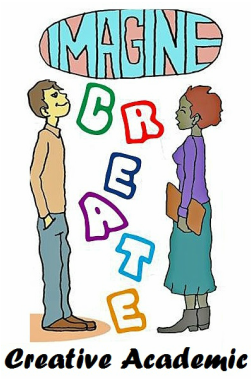
This week we published the third issue of Creative Academic Magazine which explores the idea of creativity through an online course that was designed and facilitated by Chrissi Nerantzi - one of Creative Academic's Founders.
The idea of how we might teach people to be creative is an idea that has bothered me throughout my career. I should come clean and say that while I believe teachers can, through their practices, inhibit their students' creativity, but students will always find ways of using their creativity even if it means seeking opportunities outside their academic programmes. But my over-riding belief is that many teachers believe that it's important to encourage their students' creativity and use their own creativity to find ways of doing this. The more I have thought about this the more I see the teaching project as one of creating affordance that students recognise and utilise for their own learning projects that demand their creativity and Issue 2 of the magazine provided some glorious examples of teachers creating affordances for experimenting and play in higher education. When it comes to mature learners with significant experiences of the world, education is much more about sharing these experiences and the insights that have been gained Campbell Gardener captures this well when he talks about sharing wisdom (Wisdom as a Learning Outcome TED talk). If a teacher can encourage a group of students to share their experiences and wisdom then they are likely to facilitate a great environment for learning and the development of new insights.
Over the last 12 months Chrissi Nerantzi, a champion of open learning and education through the use of social media, has been developing an on-line course 'Creativity for Learning in Higher Education' or #creativeHE (1), which creates the affordance for people to explore the idea of creativity. It has been one of Creative Academic's goals to facilitate professional development relating to creativity in higher education so I was delighted when Chrissi invited me to be involved as one of the facilitators in the second iteration of the course. This was my first complete experience of participating in an online course. I had joined a couple of moocs before but quickly became disillusioned and dropped out. This was not the case with #creativeHE and I'm very glad I stayed with it as the experience revealed to me the fantastic affordance for learning that a well structured and facilitated online course and a well connected community with a culture of sharing, can create. Over the eight weeks that the course was run I engaged in many productive conversations, met and formed good relationships with many people, learnt about and used new technological tools and generally enhanced my understandings of many things. Looking back I can see and appreciate this as a rich learning and relationship building experience. As the course came to an end in late November I had the idea that we might use the affordance of Creative Academic Magazine to consolidate and share some of the learning gained through #creativeHE and I'm delighted that Chrissi and Jenny thought it was a good idea. Furthermore, two of the most enthusiastic student participants, Nikos and Rafaela also wanted to help produce the magazine so they joined our small editorial group, along with Roger Greenhalgh, another equally enthusiastic participant in the course. So this issue of the magazine is very much the result of a co-creative effort involving the editorial team and all the participants who shared their perspectives through the #creativeHE process.
The idea of how we might teach people to be creative is an idea that has bothered me throughout my career. I should come clean and say that while I believe teachers can, through their practices, inhibit their students' creativity, but students will always find ways of using their creativity even if it means seeking opportunities outside their academic programmes. But my over-riding belief is that many teachers believe that it's important to encourage their students' creativity and use their own creativity to find ways of doing this. The more I have thought about this the more I see the teaching project as one of creating affordance that students recognise and utilise for their own learning projects that demand their creativity and Issue 2 of the magazine provided some glorious examples of teachers creating affordances for experimenting and play in higher education. When it comes to mature learners with significant experiences of the world, education is much more about sharing these experiences and the insights that have been gained Campbell Gardener captures this well when he talks about sharing wisdom (Wisdom as a Learning Outcome TED talk). If a teacher can encourage a group of students to share their experiences and wisdom then they are likely to facilitate a great environment for learning and the development of new insights.
Over the last 12 months Chrissi Nerantzi, a champion of open learning and education through the use of social media, has been developing an on-line course 'Creativity for Learning in Higher Education' or #creativeHE (1), which creates the affordance for people to explore the idea of creativity. It has been one of Creative Academic's goals to facilitate professional development relating to creativity in higher education so I was delighted when Chrissi invited me to be involved as one of the facilitators in the second iteration of the course. This was my first complete experience of participating in an online course. I had joined a couple of moocs before but quickly became disillusioned and dropped out. This was not the case with #creativeHE and I'm very glad I stayed with it as the experience revealed to me the fantastic affordance for learning that a well structured and facilitated online course and a well connected community with a culture of sharing, can create. Over the eight weeks that the course was run I engaged in many productive conversations, met and formed good relationships with many people, learnt about and used new technological tools and generally enhanced my understandings of many things. Looking back I can see and appreciate this as a rich learning and relationship building experience. As the course came to an end in late November I had the idea that we might use the affordance of Creative Academic Magazine to consolidate and share some of the learning gained through #creativeHE and I'm delighted that Chrissi and Jenny thought it was a good idea. Furthermore, two of the most enthusiastic student participants, Nikos and Rafaela also wanted to help produce the magazine so they joined our small editorial group, along with Roger Greenhalgh, another equally enthusiastic participant in the course. So this issue of the magazine is very much the result of a co-creative effort involving the editorial team and all the participants who shared their perspectives through the #creativeHE process.

Insights
The Danish philosopher Soren Kiekegaard once said, 'Life can only be understood backwards but it must be lived forwards'. I think the same is true of participating in an on-line course. When we view the curriculum laid out before us we can see the structure and a timeline for activity that was imagined by the designer, but the curriculum is a lived experienced, those who participate by sharing their thoughts and feelings, are the source of the curriculum. Of course we are aware of what emerges as it emerges but its only when it's all over, if we have the time and inclination, we can look back and make more sense of it and create deeper meaning of the experience.
If being creative is connecting ideas with other ideas, needs or experiences in ways that had not previously been connected then I have done this on several occasions as I reflected on my experience.
The first insight was the value of approaching and facilitating learning through the sort of approach used by #creativeHE using a similar range of web tools. This opens up the possibility for Creative Academic to offer similar open courses or discursive processes. Indeed I was so taken by the google+ community tool that I set up a community space called 'Our Creative Life', for the production of the December issue of Lifewide Magazine to enable people to share their stories of personal creativity
As we were finalising the magazine I came across #humanmooc (2) in my Twitter feed and followed the link to discover the Human MOOC website - an instructor-led course that sets out to humanise on-line instruction. I was too late to join the course but felt that the idea of humanized instruction and community interaction in on-line environment established for the purpose of learning, resonated with my experience of #creativeHE (my second insight). I loved the underlying wisdom in the principle of seeking to develop an environment within which our humanity can flourish. Social learning, as embodied in #creativeHE, enables people to share their experiences and the insights that have been gained. Campbell Gardener captures this well when he talks about sharing wisdom (Wisdom as Learning Outcome TED talk). If a teacher can create a culture within which people feel safe and can trust each other and be sufficiently confident to share their personal experiences and wisdom, they are likely to facilitate a great environment for social learning.
My experience of #creativeHE was that it indeed felt like a very human experience replete with deep and meaningful conversations based on shared experiences, care, compassion, empathy experiences and reveal how they feel as well as what they know., humour, insights and inspirations, creativity, commitment and new relationships and friendships. I hope that this magazine manages to communicate this, indeed I hope that this magazine is itself an extension of the humanised and humanising process that was #creativeHE.
The third insight to emerge from this post-experience reflection relates to a new purpose for our magazine. A social learning space without people is a dead space and if it is not accessible or searchable to the wider universe of learners via the internet it has little value as a resource for future learning.
The absence of curatorial tools in Google+, the main platform for community discussion, makes it extremely difficult to curate the content of #creativeHE. By creating a magazine that draws on the content and attempts to add value through analysis, synthesis, conceptualisation and other sense making processes the magazine is serving as a curatorial tool.
Perhaps we might extend the idea of a magazine based on the products of social learning as a curatorial tool, by suggesting that the production of an end of course magazine might be incorporated into a pedagogic strategy providing a useful collaborative activity for social learning and for celebrating the humanising dimensions of the experience. The challenge for facilitators is then one of building a collective with the enthusiasm and commitment to engage with this task on behalf of the whole community.
Finally, on the day the magazine is published I will be participating in a workshop organised by MELSIG on the theme of digital narratives. As I was writing this post it struck me that #creativeHE was a collection of digital narratives as participants worked through the learning activities or exchanged stories about themselves and their experiences. Furthermore, this issue of the magazine is clearly a type of meta-narrative or big-picture story that attempts to illustrate and illuminate something of the experience and the wisdom that emerged and communicate this to an interested audience.
The magazine is free to download at: http://www.creativeacademic.uk/magazine.html
Sources
(1) https://courses.p2pu.org/en/courses/2615/creativity-for-learning-in-higher-education/
(2) http://humanmooc.com/syllabus/overview/
(3) Exploring Creativity through #creativeHE Creative Academic Magazine January 2016 http://www.creativeacademic.uk/magazine.html
Norman Jackson is Founder of Creative Academic a not for profit social enterprise that promotes and supports creativity in higher education
The Danish philosopher Soren Kiekegaard once said, 'Life can only be understood backwards but it must be lived forwards'. I think the same is true of participating in an on-line course. When we view the curriculum laid out before us we can see the structure and a timeline for activity that was imagined by the designer, but the curriculum is a lived experienced, those who participate by sharing their thoughts and feelings, are the source of the curriculum. Of course we are aware of what emerges as it emerges but its only when it's all over, if we have the time and inclination, we can look back and make more sense of it and create deeper meaning of the experience.
If being creative is connecting ideas with other ideas, needs or experiences in ways that had not previously been connected then I have done this on several occasions as I reflected on my experience.
The first insight was the value of approaching and facilitating learning through the sort of approach used by #creativeHE using a similar range of web tools. This opens up the possibility for Creative Academic to offer similar open courses or discursive processes. Indeed I was so taken by the google+ community tool that I set up a community space called 'Our Creative Life', for the production of the December issue of Lifewide Magazine to enable people to share their stories of personal creativity
As we were finalising the magazine I came across #humanmooc (2) in my Twitter feed and followed the link to discover the Human MOOC website - an instructor-led course that sets out to humanise on-line instruction. I was too late to join the course but felt that the idea of humanized instruction and community interaction in on-line environment established for the purpose of learning, resonated with my experience of #creativeHE (my second insight). I loved the underlying wisdom in the principle of seeking to develop an environment within which our humanity can flourish. Social learning, as embodied in #creativeHE, enables people to share their experiences and the insights that have been gained. Campbell Gardener captures this well when he talks about sharing wisdom (Wisdom as Learning Outcome TED talk). If a teacher can create a culture within which people feel safe and can trust each other and be sufficiently confident to share their personal experiences and wisdom, they are likely to facilitate a great environment for social learning.
My experience of #creativeHE was that it indeed felt like a very human experience replete with deep and meaningful conversations based on shared experiences, care, compassion, empathy experiences and reveal how they feel as well as what they know., humour, insights and inspirations, creativity, commitment and new relationships and friendships. I hope that this magazine manages to communicate this, indeed I hope that this magazine is itself an extension of the humanised and humanising process that was #creativeHE.
The third insight to emerge from this post-experience reflection relates to a new purpose for our magazine. A social learning space without people is a dead space and if it is not accessible or searchable to the wider universe of learners via the internet it has little value as a resource for future learning.
The absence of curatorial tools in Google+, the main platform for community discussion, makes it extremely difficult to curate the content of #creativeHE. By creating a magazine that draws on the content and attempts to add value through analysis, synthesis, conceptualisation and other sense making processes the magazine is serving as a curatorial tool.
Perhaps we might extend the idea of a magazine based on the products of social learning as a curatorial tool, by suggesting that the production of an end of course magazine might be incorporated into a pedagogic strategy providing a useful collaborative activity for social learning and for celebrating the humanising dimensions of the experience. The challenge for facilitators is then one of building a collective with the enthusiasm and commitment to engage with this task on behalf of the whole community.
Finally, on the day the magazine is published I will be participating in a workshop organised by MELSIG on the theme of digital narratives. As I was writing this post it struck me that #creativeHE was a collection of digital narratives as participants worked through the learning activities or exchanged stories about themselves and their experiences. Furthermore, this issue of the magazine is clearly a type of meta-narrative or big-picture story that attempts to illustrate and illuminate something of the experience and the wisdom that emerged and communicate this to an interested audience.
The magazine is free to download at: http://www.creativeacademic.uk/magazine.html
Sources
(1) https://courses.p2pu.org/en/courses/2615/creativity-for-learning-in-higher-education/
(2) http://humanmooc.com/syllabus/overview/
(3) Exploring Creativity through #creativeHE Creative Academic Magazine January 2016 http://www.creativeacademic.uk/magazine.html
Norman Jackson is Founder of Creative Academic a not for profit social enterprise that promotes and supports creativity in higher education

 RSS Feed
RSS Feed
